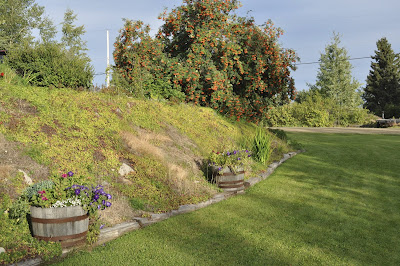Don't you love shopping for new things in the garden? Even if there aren't some glaring bare spots, it's always great to learn about new plants and just try out new things to keep the variety of plants interesting. In northern zones, the challenge is to find shrubs and perennials that will survive the winter. I was pretty pretty cautious in this year's new additions.
Among the annuals, this is a
double-flowered morning glory, which only started blooming two weeks ago:

I had RLM pick up some Viburnum in Saskatoon in the past month, based on previous successes with our existing compact Viburnum trilobum, the highbush cranberry. It forms a nice dense ball of foliage and when it is mature, grows red berries in fall. The berries aren't great for eating, but birds feed on the berries in winter and the red clusters are attractive. I highly recommend this shrub. The fact that Viburnum trilobum is a native shrub in this area should also be a good clue that it is well-adjusted and happy here.
Compact variety of Viburnum trilobum (large shrubs on the left), with a pink-flowered Potentilla at center foreground:

Potentilla are common little shrubs, though the newer colors (pink, apricot, white) are nice and they bloom over a long period of time in the later half of summer. They are low-maintenance, with only minimal trimming needed in spring.
I have high hopes for
newly planted Viburnum dentatum "Northern Burgundy":

I also got a Viburnum dentatum "Blue Muffin", which should fill out the back of the raised bed.
I bought my first ever Cimifuga recently, adding the hardy Cimifuga simplex "Brunette" to the large raised bed. It is tiny and hasn't quite developed its full color and the cluster of white flower spikes, but I will wait for that. In the meanwhile, I need to get rid of some of Siberian iris, which is blocking the view of this lovely perennial. However, digging those monster iris clumps out is too much like work!
Cimifuga simplex "Brunette":
 My young Cimifuga simplex "Brunette":
My young Cimifuga simplex "Brunette":

I've posted photos of this new mum before, but it so lovely that I will post it again.
The "Morden Fiesta" Chrysanthemum:

As any cold-climate gardener may be aware, many great plants have come out of Morden, Manitoba's agricultural research station. The Morden mums come in a few colors and are said to be hardy to zone 4. We'll see if they survive the winter here. I'm believing they will.
(June 2012 Update: One of the three survived, though the two that didn't make it were planted right up against a rock wall and likely had their roots frozen solid. I am certain that they do well planted in regular ground conditions).
Prompting another garden job, I grew weary of the drooping branches of the mountain ash, looking far too shaggy as it brushed against the perennials below.
Scraggly mountain ash tree:

We pruned the lower branches, which looks far better. It would look even nicer if we cut off some of the protruding upper branches too, but those tools are buried too far away in the shed and I'll leave it for another year. Here's a tip for anyone wanting to plant this tree -- it would be great over a lawn, but any soil or mulch underneath will end up growing hundreds of ash trees from all the fallen berries. It's a nuisance growing over the flower bed.
























































